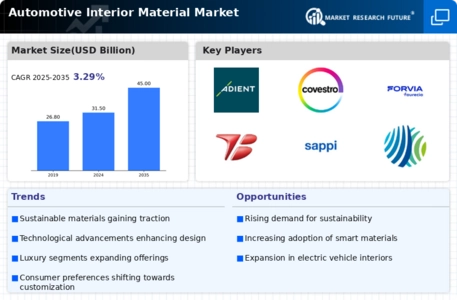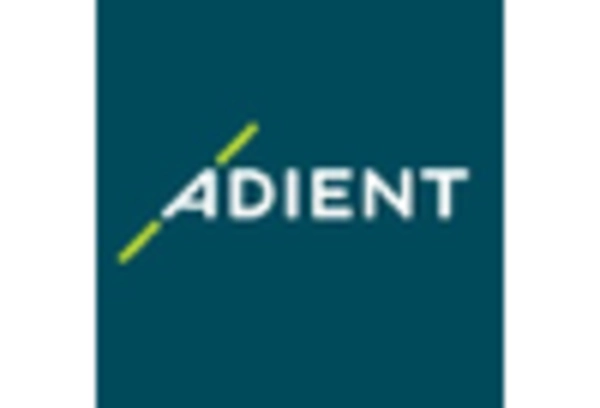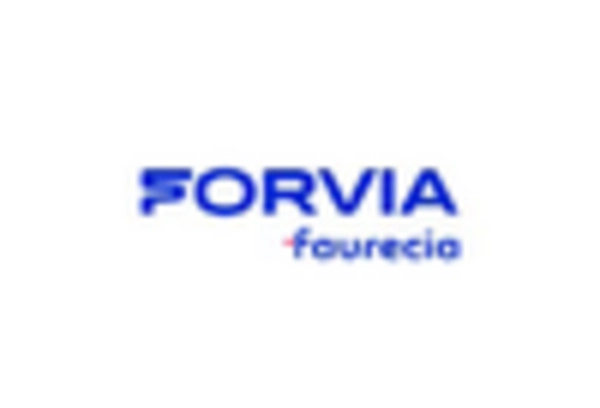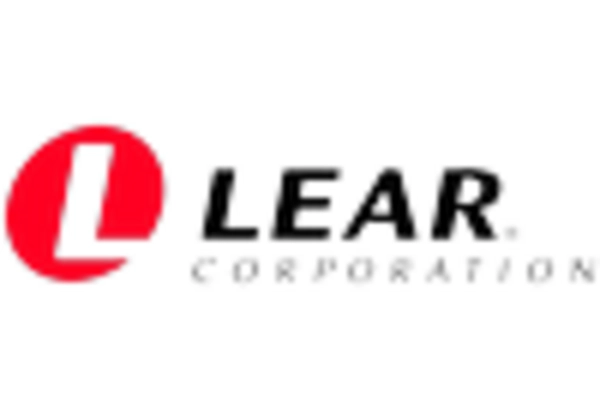Textiles
Plastic
Leather
Wood
Metal
Seats
Dashboard
Door Panels
Headliners
Flooring
Passenger Cars
Commercial Vehicles
Electric Vehicles
Luxury Vehicles
OEM
Aftermarket
North America
Europe
South America
Asia Pacific
Middle East and Africa
North America Outlook (USD Billion, 2019-2035)
North America Automotive Interior Material Market by Material Type
Textiles
Plastic
Leather
Wood
Metal
North America Automotive Interior Material Market by Application Type
Seats
Dashboard
Door Panels
Headliners
Flooring
North America Automotive Interior Material Market by Vehicle Type
Passenger Cars
Commercial Vehicles
Electric Vehicles
Luxury Vehicles
North America Automotive Interior Material Market by End Use Type
OEM
Aftermarket
North America Automotive Interior Material Market by Regional Type
US
Canada
US Outlook (USD Billion, 2019-2035)
US Automotive Interior Material Market by Material Type
Textiles
Plastic
Leather
Wood
Metal
US Automotive Interior Material Market by Application Type
Seats
Dashboard
Door Panels
Headliners
Flooring
US Automotive Interior Material Market by Vehicle Type
Passenger Cars
Commercial Vehicles
Electric Vehicles
Luxury Vehicles
US Automotive Interior Material Market by End Use Type
OEM
Aftermarket
CANADA Outlook (USD Billion, 2019-2035)
CANADA Automotive Interior Material Market by Material Type
Textiles
Plastic
Leather
Wood
Metal
CANADA Automotive Interior Material Market by Application Type
Seats
Dashboard
Door Panels
Headliners
Flooring
CANADA Automotive Interior Material Market by Vehicle Type
Passenger Cars
Commercial Vehicles
Electric Vehicles
Luxury Vehicles
CANADA Automotive Interior Material Market by End Use Type
OEM
Aftermarket
Europe Outlook (USD Billion, 2019-2035)
Europe Automotive Interior Material Market by Material Type
Textiles
Plastic
Leather
Wood
Metal
Europe Automotive Interior Material Market by Application Type
Seats
Dashboard
Door Panels
Headliners
Flooring
Europe Automotive Interior Material Market by Vehicle Type
Passenger Cars
Commercial Vehicles
Electric Vehicles
Luxury Vehicles
Europe Automotive Interior Material Market by End Use Type
OEM
Aftermarket
Europe Automotive Interior Material Market by Regional Type
Germany
UK
France
Russia
Italy
Spain
Rest of Europe
GERMANY Outlook (USD Billion, 2019-2035)
GERMANY Automotive Interior Material Market by Material Type
Textiles
Plastic
Leather
Wood
Metal
GERMANY Automotive Interior Material Market by Application Type
Seats
Dashboard
Door Panels
Headliners
Flooring
GERMANY Automotive Interior Material Market by Vehicle Type
Passenger Cars
Commercial Vehicles
Electric Vehicles
Luxury Vehicles
GERMANY Automotive Interior Material Market by End Use Type
OEM
Aftermarket
UK Outlook (USD Billion, 2019-2035)
UK Automotive Interior Material Market by Material Type
Textiles
Plastic
Leather
Wood
Metal
UK Automotive Interior Material Market by Application Type
Seats
Dashboard
Door Panels
Headliners
Flooring
UK Automotive Interior Material Market by Vehicle Type
Passenger Cars
Commercial Vehicles
Electric Vehicles
Luxury Vehicles
UK Automotive Interior Material Market by End Use Type
OEM
Aftermarket
FRANCE Outlook (USD Billion, 2019-2035)
FRANCE Automotive Interior Material Market by Material Type
Textiles
Plastic
Leather
Wood
Metal
FRANCE Automotive Interior Material Market by Application Type
Seats
Dashboard
Door Panels
Headliners
Flooring
FRANCE Automotive Interior Material Market by Vehicle Type
Passenger Cars
Commercial Vehicles
Electric Vehicles
Luxury Vehicles
FRANCE Automotive Interior Material Market by End Use Type
OEM
Aftermarket
RUSSIA Outlook (USD Billion, 2019-2035)
RUSSIA Automotive Interior Material Market by Material Type
Textiles
Plastic
Leather
Wood
Metal
RUSSIA Automotive Interior Material Market by Application Type
Seats
Dashboard
Door Panels
Headliners
Flooring
RUSSIA Automotive Interior Material Market by Vehicle Type
Passenger Cars
Commercial Vehicles
Electric Vehicles
Luxury Vehicles
RUSSIA Automotive Interior Material Market by End Use Type
OEM
Aftermarket
ITALY Outlook (USD Billion, 2019-2035)
ITALY Automotive Interior Material Market by Material Type
Textiles
Plastic
Leather
Wood
Metal
ITALY Automotive Interior Material Market by Application Type
Seats
Dashboard
Door Panels
Headliners
Flooring
ITALY Automotive Interior Material Market by Vehicle Type
Passenger Cars
Commercial Vehicles
Electric Vehicles
Luxury Vehicles
ITALY Automotive Interior Material Market by End Use Type
OEM
Aftermarket
SPAIN Outlook (USD Billion, 2019-2035)
SPAIN Automotive Interior Material Market by Material Type
Textiles
Plastic
Leather
Wood
Metal
SPAIN Automotive Interior Material Market by Application Type
Seats
Dashboard
Door Panels
Headliners
Flooring
SPAIN Automotive Interior Material Market by Vehicle Type
Passenger Cars
Commercial Vehicles
Electric Vehicles
Luxury Vehicles
SPAIN Automotive Interior Material Market by End Use Type
OEM
Aftermarket
REST OF EUROPE Outlook (USD Billion, 2019-2035)
REST OF EUROPE Automotive Interior Material Market by Material Type
Textiles
Plastic
Leather
Wood
Metal
REST OF EUROPE Automotive Interior Material Market by Application Type
Seats
Dashboard
Door Panels
Headliners
Flooring
REST OF EUROPE Automotive Interior Material Market by Vehicle Type
Passenger Cars
Commercial Vehicles
Electric Vehicles
Luxury Vehicles
REST OF EUROPE Automotive Interior Material Market by End Use Type
OEM
Aftermarket
APAC Outlook (USD Billion, 2019-2035)
APAC Automotive Interior Material Market by Material Type
Textiles
Plastic
Leather
Wood
Metal
APAC Automotive Interior Material Market by Application Type
Seats
Dashboard
Door Panels
Headliners
Flooring
APAC Automotive Interior Material Market by Vehicle Type
Passenger Cars
Commercial Vehicles
Electric Vehicles
Luxury Vehicles
APAC Automotive Interior Material Market by End Use Type
OEM
Aftermarket
APAC Automotive Interior Material Market by Regional Type
China
India
Japan
South Korea
Malaysia
Thailand
Indonesia
Rest of APAC
CHINA Outlook (USD Billion, 2019-2035)
CHINA Automotive Interior Material Market by Material Type
Textiles
Plastic
Leather
Wood
Metal
CHINA Automotive Interior Material Market by Application Type
Seats
Dashboard
Door Panels
Headliners
Flooring
CHINA Automotive Interior Material Market by Vehicle Type
Passenger Cars
Commercial Vehicles
Electric Vehicles
Luxury Vehicles
CHINA Automotive Interior Material Market by End Use Type
OEM
Aftermarket
INDIA Outlook (USD Billion, 2019-2035)
INDIA Automotive Interior Material Market by Material Type
Textiles
Plastic
Leather
Wood
Metal
INDIA Automotive Interior Material Market by Application Type
Seats
Dashboard
Door Panels
Headliners
Flooring
INDIA Automotive Interior Material Market by Vehicle Type
Passenger Cars
Commercial Vehicles
Electric Vehicles
Luxury Vehicles
INDIA Automotive Interior Material Market by End Use Type
OEM
Aftermarket
JAPAN Outlook (USD Billion, 2019-2035)
JAPAN Automotive Interior Material Market by Material Type
Textiles
Plastic
Leather
Wood
Metal
JAPAN Automotive Interior Material Market by Application Type
Seats
Dashboard
Door Panels
Headliners
Flooring
JAPAN Automotive Interior Material Market by Vehicle Type
Passenger Cars
Commercial Vehicles
Electric Vehicles
Luxury Vehicles
JAPAN Automotive Interior Material Market by End Use Type
OEM
Aftermarket
SOUTH KOREA Outlook (USD Billion, 2019-2035)
SOUTH KOREA Automotive Interior Material Market by Material Type
Textiles
Plastic
Leather
Wood
Metal
SOUTH KOREA Automotive Interior Material Market by Application Type
Seats
Dashboard
Door Panels
Headliners
Flooring
SOUTH KOREA Automotive Interior Material Market by Vehicle Type
Passenger Cars
Commercial Vehicles
Electric Vehicles
Luxury Vehicles
SOUTH KOREA Automotive Interior Material Market by End Use Type
OEM
Aftermarket
MALAYSIA Outlook (USD Billion, 2019-2035)
MALAYSIA Automotive Interior Material Market by Material Type
Textiles
Plastic
Leather
Wood
Metal
MALAYSIA Automotive Interior Material Market by Application Type
Seats
Dashboard
Door Panels
Headliners
Flooring
MALAYSIA Automotive Interior Material Market by Vehicle Type
Passenger Cars
Commercial Vehicles
Electric Vehicles
Luxury Vehicles
MALAYSIA Automotive Interior Material Market by End Use Type
OEM
Aftermarket
THAILAND Outlook (USD Billion, 2019-2035)
THAILAND Automotive Interior Material Market by Material Type
Textiles
Plastic
Leather
Wood
Metal
THAILAND Automotive Interior Material Market by Application Type
Seats
Dashboard
Door Panels
Headliners
Flooring
THAILAND Automotive Interior Material Market by Vehicle Type
Passenger Cars
Commercial Vehicles
Electric Vehicles
Luxury Vehicles
THAILAND Automotive Interior Material Market by End Use Type
OEM
Aftermarket
INDONESIA Outlook (USD Billion, 2019-2035)
INDONESIA Automotive Interior Material Market by Material Type
Textiles
Plastic
Leather
Wood
Metal
INDONESIA Automotive Interior Material Market by Application Type
Seats
Dashboard
Door Panels
Headliners
Flooring
INDONESIA Automotive Interior Material Market by Vehicle Type
Passenger Cars
Commercial Vehicles
Electric Vehicles
Luxury Vehicles
INDONESIA Automotive Interior Material Market by End Use Type
OEM
Aftermarket
REST OF APAC Outlook (USD Billion, 2019-2035)
REST OF APAC Automotive Interior Material Market by Material Type
Textiles
Plastic
Leather
Wood
Metal
REST OF APAC Automotive Interior Material Market by Application Type
Seats
Dashboard
Door Panels
Headliners
Flooring
REST OF APAC Automotive Interior Material Market by Vehicle Type
Passenger Cars
Commercial Vehicles
Electric Vehicles
Luxury Vehicles
REST OF APAC Automotive Interior Material Market by End Use Type
OEM
Aftermarket
South America Outlook (USD Billion, 2019-2035)
South America Automotive Interior Material Market by Material Type
Textiles
Plastic
Leather
Wood
Metal
South America Automotive Interior Material Market by Application Type
Seats
Dashboard
Door Panels
Headliners
Flooring
South America Automotive Interior Material Market by Vehicle Type
Passenger Cars
Commercial Vehicles
Electric Vehicles
Luxury Vehicles
South America Automotive Interior Material Market by End Use Type
OEM
Aftermarket
South America Automotive Interior Material Market by Regional Type
Brazil
Mexico
Argentina
Rest of South America
BRAZIL Outlook (USD Billion, 2019-2035)
BRAZIL Automotive Interior Material Market by Material Type
Textiles
Plastic
Leather
Wood
Metal
BRAZIL Automotive Interior Material Market by Application Type
Seats
Dashboard
Door Panels
Headliners
Flooring
BRAZIL Automotive Interior Material Market by Vehicle Type
Passenger Cars
Commercial Vehicles
Electric Vehicles
Luxury Vehicles
BRAZIL Automotive Interior Material Market by End Use Type
OEM
Aftermarket
MEXICO Outlook (USD Billion, 2019-2035)
MEXICO Automotive Interior Material Market by Material Type
Textiles
Plastic
Leather
Wood
Metal
MEXICO Automotive Interior Material Market by Application Type
Seats
Dashboard
Door Panels
Headliners
Flooring
MEXICO Automotive Interior Material Market by Vehicle Type
Passenger Cars
Commercial Vehicles
Electric Vehicles
Luxury Vehicles
MEXICO Automotive Interior Material Market by End Use Type
OEM
Aftermarket
ARGENTINA Outlook (USD Billion, 2019-2035)
ARGENTINA Automotive Interior Material Market by Material Type
Textiles
Plastic
Leather
Wood
Metal
ARGENTINA Automotive Interior Material Market by Application Type
Seats
Dashboard
Door Panels
Headliners
Flooring
ARGENTINA Automotive Interior Material Market by Vehicle Type
Passenger Cars
Commercial Vehicles
Electric Vehicles
Luxury Vehicles
ARGENTINA Automotive Interior Material Market by End Use Type
OEM
Aftermarket
REST OF SOUTH AMERICA Outlook (USD Billion, 2019-2035)
REST OF SOUTH AMERICA Automotive Interior Material Market by Material Type
Textiles
Plastic
Leather
Wood
Metal
REST OF SOUTH AMERICA Automotive Interior Material Market by Application Type
Seats
Dashboard
Door Panels
Headliners
Flooring
REST OF SOUTH AMERICA Automotive Interior Material Market by Vehicle Type
Passenger Cars
Commercial Vehicles
Electric Vehicles
Luxury Vehicles
REST OF SOUTH AMERICA Automotive Interior Material Market by End Use Type
OEM
Aftermarket
MEA Outlook (USD Billion, 2019-2035)
MEA Automotive Interior Material Market by Material Type
Textiles
Plastic
Leather
Wood
Metal
MEA Automotive Interior Material Market by Application Type
Seats
Dashboard
Door Panels
Headliners
Flooring
MEA Automotive Interior Material Market by Vehicle Type
Passenger Cars
Commercial Vehicles
Electric Vehicles
Luxury Vehicles
MEA Automotive Interior Material Market by End Use Type
OEM
Aftermarket
MEA Automotive Interior Material Market by Regional Type
GCC Countries
South Africa
Rest of MEA
GCC COUNTRIES Outlook (USD Billion, 2019-2035)
GCC COUNTRIES Automotive Interior Material Market by Material Type
Textiles
Plastic
Leather
Wood
Metal
GCC COUNTRIES Automotive Interior Material Market by Application Type
Seats
Dashboard
Door Panels
Headliners
Flooring
GCC COUNTRIES Automotive Interior Material Market by Vehicle Type
Passenger Cars
Commercial Vehicles
Electric Vehicles
Luxury Vehicles
GCC COUNTRIES Automotive Interior Material Market by End Use Type
OEM
Aftermarket
SOUTH AFRICA Outlook (USD Billion, 2019-2035)
SOUTH AFRICA Automotive Interior Material Market by Material Type
Textiles
Plastic
Leather
Wood
Metal
SOUTH AFRICA Automotive Interior Material Market by Application Type
Seats
Dashboard
Door Panels
Headliners
Flooring
SOUTH AFRICA Automotive Interior Material Market by Vehicle Type
Passenger Cars
Commercial Vehicles
Electric Vehicles
Luxury Vehicles
SOUTH AFRICA Automotive Interior Material Market by End Use Type
OEM
Aftermarket
REST OF MEA Outlook (USD Billion, 2019-2035)
REST OF MEA Automotive Interior Material Market by Material Type
Textiles
Plastic
Leather
Wood
Metal
REST OF MEA Automotive Interior Material Market by Application Type
Seats
Dashboard
Door Panels
Headliners
Flooring
REST OF MEA Automotive Interior Material Market by Vehicle Type
Passenger Cars
Commercial Vehicles
Electric Vehicles
Luxury Vehicles
REST OF MEA Automotive Interior Material Market by End Use Type
OEM
Aftermarket

















Leave a Comment